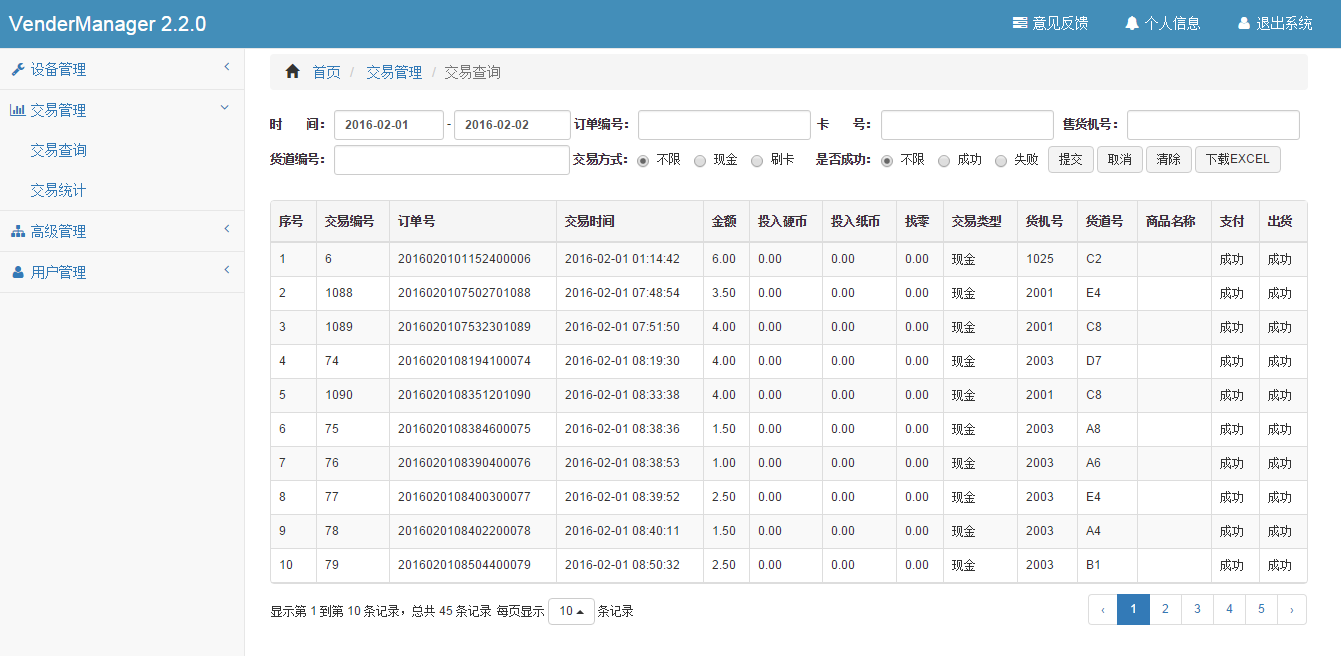
Recently, customers have made demands and want to optimize the original management system so that it can be displayed well through mobile phones. Two solutions come to mind:
Plan a: Keep the original page and design a new set of pages suitable for mobile phones. When accessed by mobile phone, enter m.zhy.com (mobile page). When accessed by PC device, enter www.zhy.com (pc page)
Plan b: Use the bootstrap framework to replace the original page and automatically adapt to mobile phones, tablets, and PC devices
If you adopt option a, you need to design an interface and rewrite the interface suitable for the page. Considering the time and cost issues, the project adopts option b
1. Effect display

2. Brief introduction to BootStrap table
bootStrap table is a lightweight table plug-in that uses AJAX to obtain data in JSON format. Its paging and data filling are very convenient and supports internationalization
3. How to use
1. Introduce js and css
<!--css样式--> <link href="css/bootstrap/bootstrap.min.css" rel="stylesheet"> <link href="css/bootstrap/bootstrap-table.css" rel="stylesheet"> <!--js--> <script src="js/bootstrap/jquery-1.12.0.min.js" type="text/javascript"></script> <script src="js/bootstrap/bootstrap.min.js"></script> <script src="js/bootstrap/bootstrap-table.js"></script> <script src="js/bootstrap/bootstrap-table-zh-CN.js"></script>
2. Table data filling
There are two ways for bootStrap table to obtain data. One is to specify the data source through the data-url attribute of the table, and the other is to obtain the data by specifying the url when initializing the table through JavaScript
<table data-toggle="table">
<thead>
...
</thead>
</table>
...
$('#table').bootstrapTable({
url: 'data.json'
});
The second method is more flexible than the first method when processing complex data. Generally, the second method is used to fill table data.
$(function () {
//1.初始化Table
var oTable = new TableInit();
oTable.Init();
//2.初始化Button的点击事件
/* var oButtonInit = new ButtonInit();
oButtonInit.Init(); */
});
var TableInit = function () {
var oTableInit = new Object();
//初始化Table
oTableInit.Init = function () {
$('#tradeList').bootstrapTable({
url: '/VenderManager/TradeList', //请求后台的URL(*)
method: 'post', //请求方式(*)
toolbar: '#toolbar', //工具按钮用哪个容器
striped: true, //是否显示行间隔色
cache: false, //是否使用缓存,默认为true,所以一般情况下需要设置一下这个属性(*)
pagination: true, //是否显示分页(*)
sortable: false, //是否启用排序
sortOrder: "asc", //排序方式
queryParams: oTableInit.queryParams,//传递参数(*)
sidePagination: "server", //分页方式:client客户端分页,server服务端分页(*)
pageNumber:1, //初始化加载第一页,默认第一页
pageSize: 50, //每页的记录行数(*)
pageList: [10, 25, 50, 100], //可供选择的每页的行数(*)
strictSearch: true,
clickToSelect: true, //是否启用点击选中行
height: 460, //行高,如果没有设置height属性,表格自动根据记录条数觉得表格高度
uniqueId: "id", //每一行的唯一标识,一般为主键列
cardView: false, //是否显示详细视图
detailView: false, //是否显示父子表
columns: [{
field: 'id',
title: '序号'
}, {
field: 'liushuiid',
title: '交易编号'
}, {
field: 'orderid',
title: '订单号'
}, {
field: 'receivetime',
title: '交易时间'
}, {
field: 'price',
title: '金额'
}, {
field: 'coin_credit',
title: '投入硬币'
}, {
field: 'bill_credit',
title: '投入纸币'
}, {
field: 'changes',
title: '找零'
}, {
field: 'tradetype',
title: '交易类型'
},{
field: 'goodmachineid',
title: '货机号'
},{
field: 'inneridname',
title: '货道号'
},{
field: 'goodsName',
title: '商品名称'
}, {
field: 'changestatus',
title: '支付'
},{
field: 'sendstatus',
title: '出货'
},]
});
};
//得到查询的参数
oTableInit.queryParams = function (params) {
var temp = { //这里的键的名字和控制器的变量名必须一直,这边改动,控制器也需要改成一样的
limit: params.limit, //页面大小
offset: params.offset, //页码
sdate: $("#stratTime").val(),
edate: $("#endTime").val(),
sellerid: $("#sellerid").val(),
orderid: $("#orderid").val(),
CardNumber: $("#CardNumber").val(),
maxrows: params.limit,
pageindex:params.pageNumber,
portid: $("#portid").val(),
CardNumber: $("#CardNumber").val(),
tradetype:$('input:radio[name="tradetype"]:checked').val(),
success:$('input:radio[name="success"]:checked').val(),
};
return temp;
};
return oTableInit;
};
The field field must correspond to the field returned by the server to display the data.
3. Obtain data in the background
a. servlet gets data
BufferedReader bufr = new BufferedReader(
new InputStreamReader(request.getInputStream(),"UTF-8"));
StringBuilder sBuilder = new StringBuilder("");
String temp = "";
while((temp = bufr.readLine()) != null){
sBuilder.append(temp);
}
bufr.close();
String json = sBuilder.toString();
JSONObject json1 = JSONObject.fromObject(json);
String sdate= json1.getString("sdate");//通过此方法获取前端数据
...
b. The corresponding method in springMvc Controller obtains data
public JsonResult GetDepartment(int limit, int offset, string orderId, string SellerId,PortId,CardNumber,Success,maxrows,tradetype)
{
...
}
4. Pagination (the most problematic one)
When using paging, the data returned by the server must include rows and total. The code is as follows:
...<br>gblst = SqlADO.getTradeList(sql,pageindex,maxrows);
JSONArray jsonData=new JSONArray();
JSONObject jo=null;
for (int i=0,len=gblst.size();i<len;i++)
{
TradeBean tb = gblst.get(i);
if(tb==null)
{
continue;
}
jo=new JSONObject();
jo.put("id", i+1);
jo.put("liushuiid", tb.getLiushuiid());
jo.put("price", String.format("%1.2f",tb.getPrice()/100.0));
jo.put("mobilephone", tb.getMobilephone());
jo.put("receivetime", ToolBox.getYMDHMS(tb.getReceivetime()));
jo.put("tradetype", clsConst.TRADE_TYPE_DES[tb.getTradetype()]);
jo.put("changestatus", (tb.getChangestatus()!=0)?"成功":"失败");
jo.put("sendstatus", (tb.getSendstatus()!=0)?"成功":"失败");
jo.put("bill_credit", String.format("%1.2f",tb.getBill_credit()/100.0));
jo.put("changes",String.format("%1.2f",tb.getChanges()/100.0));
jo.put("goodroadid", tb.getGoodroadid());
jo.put("SmsContent", tb.getSmsContent());
jo.put("orderid", tb.getOrderid());
jo.put("goodsName", tb.getGoodsName());
jo.put("inneridname", tb.getInneridname());
jo.put("xmlstr", tb.getXmlstr());
jsonData.add(jo);
}
int TotalCount=SqlADO.getTradeRowsCount(sql);
JSONObject jsonObject=new JSONObject();
jsonObject.put("rows", jsonData);//JSONArray
jsonObject.put("total",TotalCount);//总记录数
out.print(jsonObject.toString()); <br>...
5. Introduction to the content of the paging interface

The front-end gets the paging data, the code is as follows:
...<br>oTableInit.queryParams = function (params) {
var temp = { //这里的键的名字和控制器的变量名必须一直,这边改动,控制器也需要改成一样的
limit: params.limit, //第几条记录
offset: params.offset, //显示一页多少记录
sdate: $("#stratTime").val(),
};
return temp;
};<br>...
The backend gets the paging data, the code is as follows:
...<br>int pageindex=0;
int offset = ToolBox.filterInt(json1.getString("offset"));
int limit = ToolBox.filterInt(json1.getString("limit"));
if(offset !=0){
pageindex = offset/limit;
}
pageindex+= 1;//第几页<br>...The above is how to use Bootstrap Table shared with you. I hope it will be helpful for everyone to master the use of Bootstrap Table.




